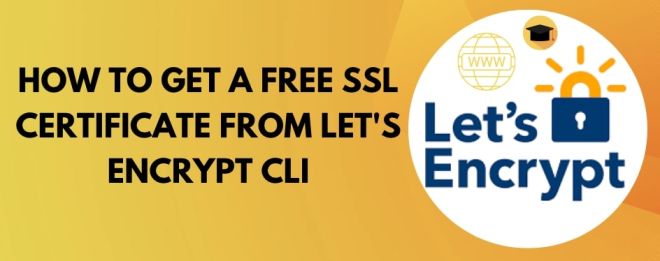
Introduction
Securing your website with an SSL certificate is essential for protecting your users’ sensitive data and maintaining their trust. One popular and cost-effective option for obtaining an SSL certificate is Let’s Encrypt, which provides free, automated SSL certificates through their CLI (command-line interface). In this article, we will guide you through the process of getting a free SSL certificate from Let’s Encrypt CLI using a tool called Certbot.
Step 1: Install Certbot
Certbot is an easy-to-use client that helps you acquire and manage SSL certificates from Let’s Encrypt. To install Certbot, follow the instructions below, depending on your operating system:
Ubuntu/Debian systems:
sudo apt-get update
sudo apt-get install software-properties-common
sudo add-apt-repository universe
sudo add-apt-repository ppa:certbot/certbot
sudo apt-get update
sudo apt-get install certbotCentOS/RHEL systems:
sudo yum install epel-release
sudo yum install certbotFor other systems, please check the official Certbot documentation: https://certbot.eff.org/docs/install.html
Step 2: Obtain the SSL Certificate
To obtain a certificate for your domain, use the following command, replacing yourdomain.com with your actual domain name:
sudo certbot certonly --standalone -d yourdomain.com -d www.yourdomain.comCertbot will automatically perform a challenge to verify domain ownership and request the SSL certificate. If successful, the certificate and key files will be stored in /etc/letsencrypt/live/yourdomain.com/.
Step 3: Configure Your Web Server
You’ll need to configure your web server to use the SSL certificate. The exact process depends on your web server (Apache, Nginx, etc.). Check the Certbot documentation for instructions specific to your web server: https://certbot.eff.org/docs/using.html#where-are-my-certificates
Step 4: Set Up Automatic Renewal
Let’s Encrypt certificates are valid for 90 days. To automatically renew your certificates before they expire, set up a cron job or systemd timer. For example, you can add the following line to your /etc/crontab file:
0 3 * * * root certbot renew --quietThis will attempt to renew your certificates daily at 3 AM if they are within 30 days of expiration.
Conclusion
By following these simple steps, you can easily obtain a free SSL certificate from Let’s Encrypt CLI using Certbot. Not only will you secure your website and protect user data, but you’ll also improve your search engine ranking, as SSL certificates are now a crucial factor in SEO. Remember to keep your certificates updated by setting up automatic renewal, and enjoy the benefits of a secure and trustworthy online presence.
More from Let’s Encrypt
Let’s Encrypt is a powerful and versatile tool for managing SSL certificates. In addition to obtaining free SSL certificates, you can use Let’s Encrypt for various tasks such as:
Wildcard SSL Certificates
Let’s Encrypt also offers free wildcard SSL certificates, which cover all subdomains of a domain with a single certificate. To obtain a wildcard SSL certificate, use the following command:
sudo certbot certonly --manual --preferred-challenges dns -d "*.yourdomain.com"You will need to create a DNS TXT record for domain validation during this process.
Expanding Existing Certificates
If you need to add more domains or subdomains to an existing certificate, you can use the –expand flag. For example:
sudo certbot certonly --expand -d yourdomain.com,www.yourdomain.com,newsubdomain.yourdomain.comThis command will replace the existing certificate with a new one that includes the additional domain(s).
Revoking SSL Certificates
If you need to revoke an SSL certificate, you can use the revoke command:
If you need to revoke an SSL certificate, you can use the revoke command:After revoking a certificate, you should also delete it:
sudo certbot delete --cert-name yourdomain.comViewing Certificate Information
To view information about your installed certificates, such as their expiration dates, use the certificates command:
sudo certbot certificatesTesting Certificate Renewal
You can test the renewal process for your certificates using the renew command with the –dry-run flag:
sudo certbot renew --dry-runThis command will simulate the renewal process without making any actual changes.
Configuring Web Server Plugins
Certbot supports various web server plugins that can automate the process of obtaining and installing SSL certificates. Some popular plugins include:
certbot-apache: Apache plugin
certbot-nginx: Nginx plugin
To install a plugin, use the package manager for your operating system (e.g., apt-get or yum). Once installed, you can obtain and install a certificate with a single command:
sudo certbot --apache -d yourdomain.com -d www.yourdomain.comReplace --apache with --nginx if you are using Nginx.
These are just a few of the many tasks you can accomplish with Let’s Encrypt and Certbot. The official documentation (https://certbot.eff.org/docs/) provides more information and advanced usage examples.
You May Also Like: Create a QR Code from Text or URLFollow us on LinkedIn for updates!




